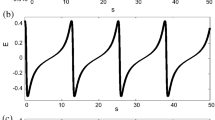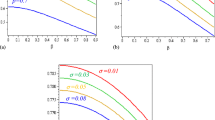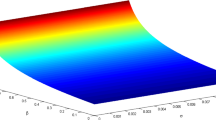Abstract
The non-linear propagation of different kinds of ion-acoustic waves (IAWs) in multi-component plasma involving proton beam, positive ions and isothermal electrons has been studied. Using the derivative expansion method of basic equations, namely the hydrodynamic and Poisson equations, they are reduced to a single evolution equation of the non-linear Schrödinger (NLS)-type equation. By applying this model to plasma formed in Earth’s magnetosphere, different waves can be predicted that express the properties of the plasma. Using the separating variables method and the \(G^{{\prime}}/G\)-expansion method, we derived the exact analytical solutions to the evolution equation by using different solution regions in which non-linear waves are defined. A comparison has been made between the solutions describing the differential equation in each region in which the solution can appear using the data on the Earth’s magnetosphere in the study by Alotaibi et al. (2021).


















Similar content being viewed by others
References
Afify, M.S., Tolba, R.E., Moslem, W.M.: The mechanism that drives electrostatic solitary waves to propagate in the Earth’s magnetosphere and solar wind. Contrib. Plasma Phys. 62(9), e202200041 (2022)
Al-Yousef, H.A., Alotaibi, B., Tolba, R., Moslem, W.: Arbitrary amplitude dust-acoustic waves in Jupiter atmosphere. Results Phys. 21, 103792 (2021)
Ali, S., Masood, W., Rizvi, H., Jahangir, R., Mirza, A.M.: Contribution of the generalized (r, q) distributed electrons in the formation of nonlinear ion acoustic waves in upper ionospheric plasmas. AIP Adv. 11(12), 125020 (2021)
Alotaibi, B., Al-Yousef, H.A., Tolba, R., Moslem, W.: Nonlinear dust-acoustic modes in homogeneous dusty plasmas: bifurcation analysis. Phys. Scr. 96(12), 125611 (2021)
Bakhmetieva, N.V., Kulikov, Y.Y., Zhemyakov, I.N.: Mesosphere ozone and the lower ionosphere under plasma disturbance by powerful high-frequency radio emission. Atmosphere 11(11), 1154 (2020)
Das, A.: Integrable Models. World Scientific Lecture Notes in Physics, vol. 30. World scientific, Singapore (1989)
Evans, M., Gras, S., Fritschel, P., Miller, J., Barsotti, L., Martynov, D., Brooks, A., Coyne, D., Abbott, R., Adhikari, R.X., et al.: Observation of parametric instability in advanced ligo. Phys. Rev. Lett. 114(16), 161102 (2015)
Gharaee, H., Afghah, S., Abbasi, H.: Modulational instability of ion-acoustic waves in plasmas with superthermal electrons. Phys. Plasmas 18(3), 032116 (2011)
Golikov, I., Gololobov, A.Y., Popov, V.: Modeling the electron temperature distribution in f2 region of high-latitude ionosphere for winter solstice conditions. Sol.-Terr. Phys. 2(4), 70–80 (2016)
Helling, C., Worters, M., Samra, D., Molaverdikhani, K., Iro, N.: Understanding the atmospheric properties and chemical composition of the ultra-hot Jupiter hat-p-7b-iii. Changing ionisation and the emergence of an ionosphere. Astron. Astrophys. 648, A80 (2021)
Honzawa, T., Kawai, Y.: Ion heating caused by ion acoustic waves in an ion-streaming plasma. Plasma Phys. 14(1), 27 (1972)
Khan, G., Kumail, Z., Khan, Y., Ullah, I., Adnan, M.: On the existence and formation of small amplitude electrostatic double-layer structure in nonthermal dusty plasma. Contrib. Plasma Phys. 60(8), e201900177 (2020)
Levine, E.V., Bernhardt, P.A., Sulzer, M.P., Sultan, P.J., Henderson, B.S., Nossa, E., Briczinski, S.C., Perillat, P.: Plasma cavity formation during ionospheric heating at Arecibo. J. Geophys. Res. Space Phys. 125(7), e2019JA027715 (2020)
Ma, B.-K., Guo, L.-X., Su, H.-T., Zhang, B.-C., Hu, H.-Q.: Incoherent scatter spectrum of ionospheric plasma with an anisotropic temperature ion distribution. Astrophys. Space Sci. 340(2), 237–243 (2012)
Malik, H.K., Srivastava, R., Kumar, S., Singh, D.: Small amplitude dust acoustic solitary wave in magnetized two ion temperature plasma. J. Taibah Univ. Sci. 14(1), 417–422 (2020)
Moslem, W., Salem, S., Sabry, R., Lazar, M., Tolba, R., El-Labany, S.: Ion escape from the upper ionosphere of Titan triggered by the solar wind. Astrophys. Space Sci. 364(9), 1–7 (2019a)
Moslem, W., Tolba, R., Ali, S.: Potentials of a moving test charge during the solar wind interaction with dusty magnetosphere of Jupiter. Phys. Scr. 94(7), 075601 (2019b)
Moslem, W., El-Said, A.S., Tolba, R., Bahlouli, H.: Modifications of single walled carbon nanotubes by ion-induced plasma. Results Phys. 37, 105438 (2022)
Mushinzimana, X., Nsengiyumva, F.: Large amplitude ion-acoustic solitary waves in a warm negative ion plasma with superthermal electrons: the fast mode revisited. AIP Adv. 10(6), 065305 (2020)
Mushinzimana, X., Nsengiyumva, F., Yadav, L.: Large amplitude slow ion-acoustic solitons, supersolitons, and double layers in a warm negative ion plasma with superthermal electrons. AIP Adv. 11(2), 025325 (2021)
Patel, A., Sharma, M., Ganesh, R., Ramasubramanian, N., Chattopadhyay, P.: Experimental observation of drift wave turbulence in an inhomogeneous six-pole cusp magnetic field of mpd. Phys. Plasmas 25(11), 112114 (2018)
Pavlov, A., Abe, T., Oyama, K.-I.: Comparison of the measured and modelled electron densities and temperatures in the ionosphere and plasmasphere during 20-30 January, 1993. In: Annales Geophysicae, vol. 18, pp. 1257–1262 (2000). Copernicus GmbH
Sabry, R., Moslem, W., Shukla, P.: Amplitude modulation of hydromagnetic waves and associated rogue waves in magnetoplasmas. Phys. Rev. E 86(3), 036408 (2012)
Salem, S., Moslem, W., Radi, A.: Expansion of Titan atmosphere. Phys. Plasmas 24(5), 052901 (2017)
Scott, A.: Nonlinear Science, vol. 4. Oxford University Press, Oxford (1999)
Shrira, V., Voronovich, V., Kozhelupova, N.: Explosive instability of vorticity waves. J. Phys. Oceanogr. 27(4), 542–554 (1997)
Thidé, B., Derblom, H., Hedberg, Å., Kopka, H., Stubbe, P.: Observations of stimulated electromagnetic emissions in ionospheric heating experiments. Radio Sci. 18(6), 851–859 (1983)
Thompson, A.R., Moran, J.M., Swenson, G.W.: Interferometry and Synthesis in Radio Astronomy. Springer, New York (2017)
Tolba, R.E.: Propagation of dust-acoustic nonlinear waves in a superthermal collisional magnetized dusty plasma. Eur. Phys. J. Plus 136(1), 1–15 (2021)
Tolba, R., Moslem, W., Elsadany, A., El-Bedwehy, N., El-Labany, S.: Development of cnoidal waves in positively charged dusty plasmas. IEEE Trans. Plasma Sci. 45(9), 2552–2560 (2017)
Tolba, R., Yahia, M., Moslem, W.: Nonlinear dynamics in the Jupiter magnetosphere: implications of dust-acoustic cnoidal mode. Phys. Scr. 96(12), 125637 (2021)
Yahia, M., Tolba, R., Moslem, W.: Super rogue wave catalysis in Titan?s ionosphere. Adv. Space Res. 67(4), 1412–1424 (2021)
Acknowledgements
This project was funded by the Deanship of Scientific Research (DSR), King Abdulaziz University, Jeddah under grant No. (G:187-665-1443). Therefore, the authors gratefully acknowledge the DSR’s technical financial support.
Author information
Authors and Affiliations
Contributions
N.S. Alharthi: Conceptualisation, Software, Writing – review, Supervision. R.E. Tolba: Methodology, Formal analysis, Review & Editing.
Corresponding authors
Ethics declarations
Competing interests
The authors declare no competing interests.
Additional information
Publisher’s Note
Springer Nature remains neutral with regard to jurisdictional claims in published maps and institutional affiliations.
Appendix
Appendix
Rights and permissions
Springer Nature or its licensor (e.g. a society or other partner) holds exclusive rights to this article under a publishing agreement with the author(s) or other rightsholder(s); author self-archiving of the accepted manuscript version of this article is solely governed by the terms of such publishing agreement and applicable law.
About this article
Cite this article
Alharthi, N.S., Tolba, R.E. Propagation of different kinds of non-linear ion-acoustic waves in Earth’s magnetosphere. Astrophys Space Sci 367, 113 (2022). https://doi.org/10.1007/s10509-022-04148-0
Received:
Accepted:
Published:
DOI: https://doi.org/10.1007/s10509-022-04148-0




